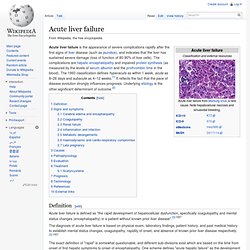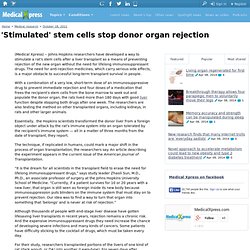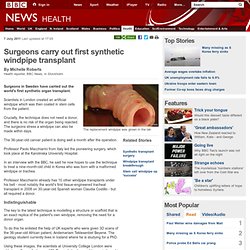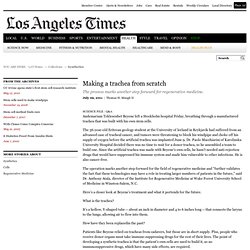

Acute liver failure. Acute liver failure is the appearance of severe complications rapidly after the first signs of liver disease (such as jaundice), and indicates that the liver has sustained severe damage (loss of function of 80-90% of liver cells).

The complications are hepatic encephalopathy and impaired protein synthesis (as measured by the levels of serum albumin and the prothrombin time in the blood). The 1993 classification defines hyperacute as within 1 week, acute as 8–28 days and subacute as 4–12 weeks.[1] It reflects the fact that the pace of disease evolution strongly influences prognosis. Underlying etiology is the other significant determinant of outcome.[2] Definition[edit] Acute liver failure is defined as "the rapid development of hepatocellular dysfunction, specifically coagulopathy and mental status changes (encephalopathy) in a patient without known prior liver disease".[3]:1557 Signs and symptoms[edit] Cerebral edema and encephalopathy[edit] Coagulopathy[edit] Renal failure[edit] [edit] Novel treatment cures liver failure. Novel treatment cures liver failure Eight-month-old Iyaad Syed received liver cell injection.

Doctors have for the first time cured a child with life threatening acute liver failure by injecting liver cells in to his abdomen and without organ transplantation. Eight-month-old Iyaad Syed received the pioneering treatment after doctors at London's King's College Hospital found that he may not survive enough to get a suitable organ donor. Doctors injected a group of donated human liver cells into the baby's abdomen. The cells were coated with a chemical found in algae which prevented them from being attacked by the immune system.
The implanted cells acted as a temporary liver, processed toxins and produced vital proteins. 'Stimulated' stem cells stop donor organ rejection. (Medical Xpress) -- Johns Hopkins researchers have developed a way to stimulate a rat’s stem cells after a liver transplant as a means of preventing rejection of the new organ without the need for lifelong immunosuppressant drugs.

The need for anti-rejection medicines, which carry serious side effects, is a major obstacle to successful long-term transplant survival in people. With a combination of a very low, short-term dose of an immunosuppressive drug to prevent immediate rejection and four doses of a medication that frees the recipient’s stem cells from the bone marrow to seek out and populate the donor organ, the rats lived more than 180 days with good liver function despite stopping both drugs after one week. The researchers are also testing the method on other transplanted organs, including kidneys, in rats and other larger animals.
Blood vessels from your printer? Researchers have been working at growing tissue and organs in the laboratory for a long time. Today, tissue engineering enables us to build up artificial tissue, although science still hasn't been successful with larger organs. Now, researchers at Fraunhofer are applying new techniques and materials to come up with artificial blood vessels in their BioRap project that will be able to supply necessary nutrients to artificial tissue and maybe even complex organs in the future. They are exhibiting their findings at the Biotechnica Fair that will be taking place in Hannover, Germany on October 11-13. 3-D printer used to make bone-like material. It looks like bone.

It feels like bone. For the most part, it acts like bone. Surgeons carry out first synthetic windpipe transplant. 7 July 2011Last updated at 17:03 By Michelle Roberts Health reporter, BBC News, in Stockholm The replacement windpipe was grown in the lab Surgeons in Sweden have carried out the world's first synthetic organ transplant.

Scientists in London created an artificial windpipe which was then coated in stem cells from the patient. Crucially, the technique does not need a donor, and there is no risk of the organ being rejected. The surgeons stress a windpipe can also be made within days. Transplant breathes new life. Q&A: Trachea implant: How to make it from scratch.
Andemariam Teklesenbet Beyene left a Stockholm hospital Friday, breathing through a manufactured trachea that was built with his own stem cells.

The 36-year-old Eritrean geology student at the University of Iceland in Reykjavik had suffered from an advanced case of tracheal cancer, and tumors were threatening to block his windpipe and choke off his supply of oxygen before the artificial trachea was implanted June 9. Dr. Paolo Macchiarini of Karolinska University Hospital decided there was no time to wait for a donor trachea, so he assembled a team to build one. Since the artificial trachea was made with Beyene's own cells, he hasn't needed anti-rejection drugs that would have suppressed his immune system and made him vulnerable to other infections. He is also cancer-free. The operation marks another step forward for the field of regenerative medicine and "further validates the fact that these technologies may have a role in treating larger numbers of patients in the future," said Dr.